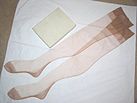
Boothose (boot-hose, boot hose) are over-stockings or boot liners worn in the sixteenth and seventeenth centuries to protect fine knitted stockings from wear. They first appear around 1450.
Originally a practical item, they were later made of fine linen and sported elaborate lace and embroidered boothose tops. By 1583 Philip Stubbs in his Anatomie of Abuses could decry "The vain excesse of botehosen"
...they must be wrought all ouer, from the gartering place vpward, with nedle worke, clogged with silk of all colors, with birds, foules, beasts, and antiques purtrayed all ouer in comlie sorte. So that I haue knowen the very nedle work of some one payre of these bootehose to stand, some in .iiij. pound, vi. pound, and some in x. pound a péece.
In the 17th century, linen boothose could be trimmed with lavish lace tops turned down over cuffed bucket-topped boots. In mid-century, it was briefly stylish to wear boothose with low-cut shoes, before boothose fell completely out of fashion. They lingered, once again a practical object, under the name boot stockings into the 18th century.
See also
References
- ^ Cumming, Valerie; Cunnington, C. W.; Cunnington, P. E. (2010-11-15). The Dictionary of Fashion History. Oxford ; New York: Bloomsbury Academic. p. 26. ISBN 9781847885333.
- Spufford, Margaret; Mee, Susan (2018-01-02). The Clothing of the Common Sort, 1570-1700. Pasold Studies in Textile History. Oxford, New York: Oxford University Press. p. 263. ISBN 978-0-19-880704-9.
- Stubbes, Philip. "The Anatomie of Abuses". University of Oxford Text Archive. Retrieved 5 February 2018.
- Gordenker, Emilie E. S. (2002-02-27). Van Dyck and the Representation of Dress in Seventeenth-Century Portraiture. Turnhout, Belgium: Brepols Publishers. p. 83. ISBN 978-2-503-50880-1.
- Ribeiro, Aileen: Fashion and Fiction: Dress in Art and Literature in Stuart England, Yale, 2005, ISBN 0-300-10999-7
| Hosiery | ||
|---|---|---|
| Lower leg |  | |
| Full leg | ||
| Full body | ||
| Historical | ||
| Brands | ||